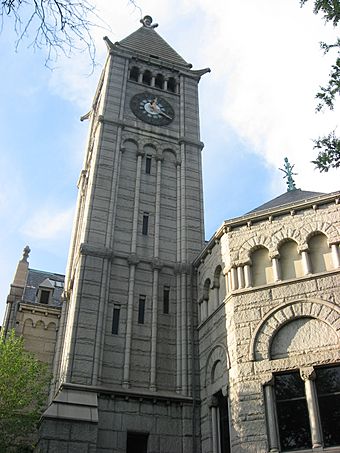Carnegie Free Library of Allegheny facts for kids
|
Carnegie Free Library of Allegheny
|
|
 |
|
| Location | Allegheny Center, Pittsburgh, Pennsylvania |
|---|---|
| Area | 1 acre (0.40 ha) |
| Built | 1886–90 |
| Architect | Smithmeyer & Pelz |
| Architectural style | Romanesque Revival, Richardsonian Romanesque |
| NRHP reference No. | 74001736 |
Quick facts for kids Significant dates |
|
| Added to NRHP | November 1, 1974 |
The Carnegie Free Library of Allegheny is a historic building in the Allegheny Center neighborhood of Pittsburgh, Pennsylvania. It was a gift to the public from a famous businessman named Andrew Carnegie. The library was built between 1886 and 1890. Its design came from architects John L. Smithmeyer and Paul J. Pelz.
Contents
A Special First Library
This library was the very first Carnegie library to be planned in the United States. Andrew Carnegie wanted to help people learn and grow. He decided to build libraries for communities. Even though it was planned first, it opened in 1890. This made it the second Carnegie library to open its doors. The first one to open was the Carnegie Free Library of Braddock. That library was built for steelworkers in Braddock, a town near Pittsburgh.
What Else Was Special About This Building?
The Carnegie Free Library of Allegheny also had another important "first." It was home to the first Carnegie Music Hall in the United States. This was a special place for concerts and performances. The Music Hall at the Braddock Library opened later, in 1893.
How the Library Was Supported
Most libraries need money to operate. The Allegheny library's daily costs were paid for by local taxes. This was different from the Braddock library. The Braddock library received a special fund from Andrew Carnegie himself. This fund helped pay for its ongoing needs.
New Home and New Uses
In the mid-2000s, the library building was hit by lightning. Because of this, the library moved to a new building. This new location is just a few blocks north on Federal Street. After the library moved out, the old building found new life. The New Hazlett Theater became the main tenant. It uses the historic space for plays and shows.
In April 2019, the Children's Museum of Pittsburgh opened something new there. It's called Museum Lab. This is a special place where young people, aged 10 and up, can create and learn. It's like a workshop for kids!
The Carnegie Free Library of Allegheny building is very important. It was added to the National Register of Historic Places in 1974. This means it's recognized as a significant historic site.
Gallery
-
A monument to Colonel James Anderson. He inspired Andrew Carnegie to create free libraries.









